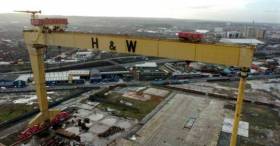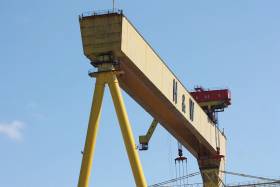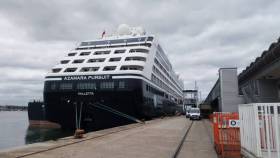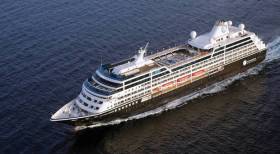Displaying items by tag: Harland & Wolff
Harland & Wolff: Call for Former Staff to Return to Shipyard on Sunday Part of Campaign to Save Jobs
Retired and former Harland and Wolff workers, writes Belfast Telegraph, have been invited to return to the shipyard on Sunday as part of a special event.
Concrete prints will be made of the "hands that built the shipyard" during an event at 12pm.
Unite shop steward at the shipyard Joe Passmore said that the event is part of the staff occupation in an effort to save jobs, with Harland and Wolff entering administration earlier this week.
“The gesture of concrete hand prints is a testament to the people who built this great industry. The yard means so much to this city and beyond, it needs to be re-nationalised," Mr Passmore said.
We need to take ownership. All hands on deck - let’s save our shipyard."
To read more including what trade union UNITE had to say click here.
Belfast Shipyard: Bidders Express Interest in Buying Harland and Wolff, Administrators Confirm
Potential bidders, reports Belfast Telegraph, have expressed an interest in buying Harland and Wolff, administrators have confirmed.
Insolvency experts Brian Murphy and Michael Jennings from business advisory firm BDO are now running the business.
On Wednesday the majority of the 123 staff have been able to opt for temporary lay-offs, a move which maintains their employment contracts. However, some have already opted for redundancy.
A spokesperson for BDO said on Friday: "In light of insufficient funds to cover the current running costs of the business and in the absence of any other funds being available at this point, in conjunction with Unions, the administrators have agreed to facilitate an unpaid temporary lay-off until Friday 16th August.
The newspaper here has more on the story.
Belfast Shipyard Harland & Wolff Enters Formal Administration
BBC News reports that Harland and Wolff has entered administration, with accountancy firm BDO formally appointed to oversee the Belfast shipyard.
Having employed more than 30,000 at its peak, the move could now put 120 jobs at risk and spell the end of the iconic firm, best known for building the Titanic.
Unions representing workers have called for the shipyard to be renationalised.
They argue it would be cheaper for the government to keep the shipyard open.
However, the government has said the crisis is "ultimately a commercial issue".
The Northern Ireland Office said NI Secretary Julian Smith "understands the impact" uncertainty over the shipyard will have for workers and their families.
It said Mr Smith "had made it clear that he will continue to do everything he can to secure the future of this historic site and ensure workers' interests are protected".
More here on this development at the Queen's Island shipyard.
Harland and Wolff’s Norwegian majority owner has announced it will file for bankruptcy — but the Belfast shipyard says business will continue as usual, as the Belfast Telegraph reports.
The move comes after Dolphin Drilling ASA, formerly Fred Olsen Energy, says it failed to reach a deal with its creditors.
Harland and Wolff, which in recent years has diversified from shipbuilding to the renewable energy sector, is expected to be sold this year as part of its parent company’s restructuring plan.
A spokesperson for Harland and Wolff Heavy Industries Ltd said: “The announced developments in relation to DDASA are not expected to impact this sales process and we are operating very much on a business as usual basis.”
The Belfast Telegraph has more on the story HERE.
Milestone for Belfast Cranes Samson and Goliath
#BelfastLough - This month 50 years ago, November 1968 the landscape of Belfast was forever changed when a giant yellow crane known as Goliath rose from the Harland and Wolff shipyard.
As BBC News NI recalls, it would be joined soon afterwards by Samson, and the pair formed a key part of the city's skyline.
Their role, however, was more than aesthetic; they were the workhorses that helped develop the city's industrial reputation, facilitating the employment many thousands within Belfast and beyond.
To view historic footage of the iconic crane, click here to a link.
Could the cranes as Afloat previously covered become tourist attractions? click here
Belfast Refitted Azamara Pursuit Christened
#CruiseLiners - New to Azamara Club Cruises is the Azamara Pursuit which was officially named in Southampton yesterday, 28 August.
The 30,277gt Azamara Pursuit writes the Maritime Executive was previously P&O Cruises' Adonia, and she sailed her final voyage as Adonia in February 2018. She has since undergone a two-and-a-half-month refurbishment at Grand Bahamas Shipyard before sailing to the U.K. Here she received further enhancements at Harland & Wolff shipyard in Belfast, Northern Ireland.
Azamara CEO Larry Pimentel says the line's third ship will enable it to visit all seven continents next year, notable South America, and to go to 400 ports annually. The ship is scheduled to visit 61 destinations, including 15 maiden calls for the line. The three ships will undertake a joint cruise together going from Slovenia to Venice in 2020.
The godmothers of the 702-passenger ship are Ellen Asmodeo-Giglio, executive vice president and chief revenue officer of Afar Media, and Lucy Huxley, editor in chief of Travel Weekly UK.
#BelfastLough - Chief executive of Azamara Club Cruises, the firm which has docked its Azamara Pursuit in Belfast for a £50m makeover, said the project could see the "renaissance" of a bygone industry here, writes The Belfast Telegraph.
Larry Pimentel, whose cruise line is part of the Royal Caribbean family, made the comments as he viewed the progress of his cruise vessel's refit, which is being carried out at Harland and Wolff in Belfast by staff from Newry firm MJM Group.
"It is my expectation that this will be the beginning of a burgeoning trade. We'll come to Belfast and bring jobs for the craftsmanship and the bespoke capabilities of a bygone era. I view this as the beginning of something exciting," said Mr Pimentel who was previously chief executive of Cunard Line and Seabourn Cruise Line.
The Miami-based chief believes that other cruise lines around the world will follow Royal Caribbean's lead by bringing more projects here.
For further reading of the story click the link.
#BelfastLough - Chief Executive Robert Cooper has stepped down from his position in Harland & Wolff Group after a 44-year career at the shipyard, where he has been replaced by Jonathan Guest.
As The Irish News reports, he began his career at H&W as an accountant in 1974 and rose through its ranks during a time of great transition including the privatisation of the company and its purchase by Norwegian stock exchange listed Fred Olsen Energy. He had been CEO since February 2003.
His successor, who assumed the new role yesterday (May 1), had been director of business development and improvement for H&W Heavy Industries, having joined the firm four years ago from interior fit-out specialist MJM Group.
For more on the change of chief executive, click here.
#BelfastLough - MJM Group based in Newry, Co. Down has landed a major new deal which will see it refit a major cruiseship at Harland & Wolff in Belfast.
The move writes the Belfast Telegraph, is part of a recent multi-million pound contract between cruise operators Royal Caribbean and Azamara Club and the specialist high-end fitout company, MJM Group. It also marks the first time a cruise ship firm has awarded complete project management responsibility to an individual organisation.
MJM Group will project manage the docking, berthing and refit of the Azamara Pursuit in Belfast this April and the ship will make its maiden voyage in August.
Gary Annett, chief executive of MJM Group, said the deal is a “milestone opportunity” for the company.
"The success of this project has the potential to be a game-changer for the UK maritime industry. By securing this multi-million pound contract we are putting Northern Ireland, and the UK’s marine industry in a strong position to compete for future drydock and refit works," he said.
To read more on this cruise industry contract, click here.
Bid By Harland & Wolff For Work on £1.25bn MoD Shipbuilding Scheme
#BelfastLough - A bid has been placed by Belfast yard Harland & Wolff on a £1.25bn MoD shipbuilding scheme. According to the Belfast Telegraph, the UK Government wants to build five new ships, each worth £250m.
In September, the newspaper reported that Titanic-builder Harland & Wolff, which once employed 35,000 workers at its peak back in the 1920s, but now is down to a workforce of 115, said it hoped to be in the running for work on the ships.
Now, according to the Financial Times, it is teaming up with companies, including weapons firm Thales — which employs more than 500 people in Belfast — to bid for constructon of the ships.
Last year, David McVeigh, head of sales and marketing at Harland and Wolff Heavy Industries, said: "H&W have supported the development of the National Shipbuilding Strategy and look forward to engaging further with the Ministry of Defence and industry partners in an effort to secure work on the T31e programme and create shipbuilding jobs".
For more on the story, click here.




































































